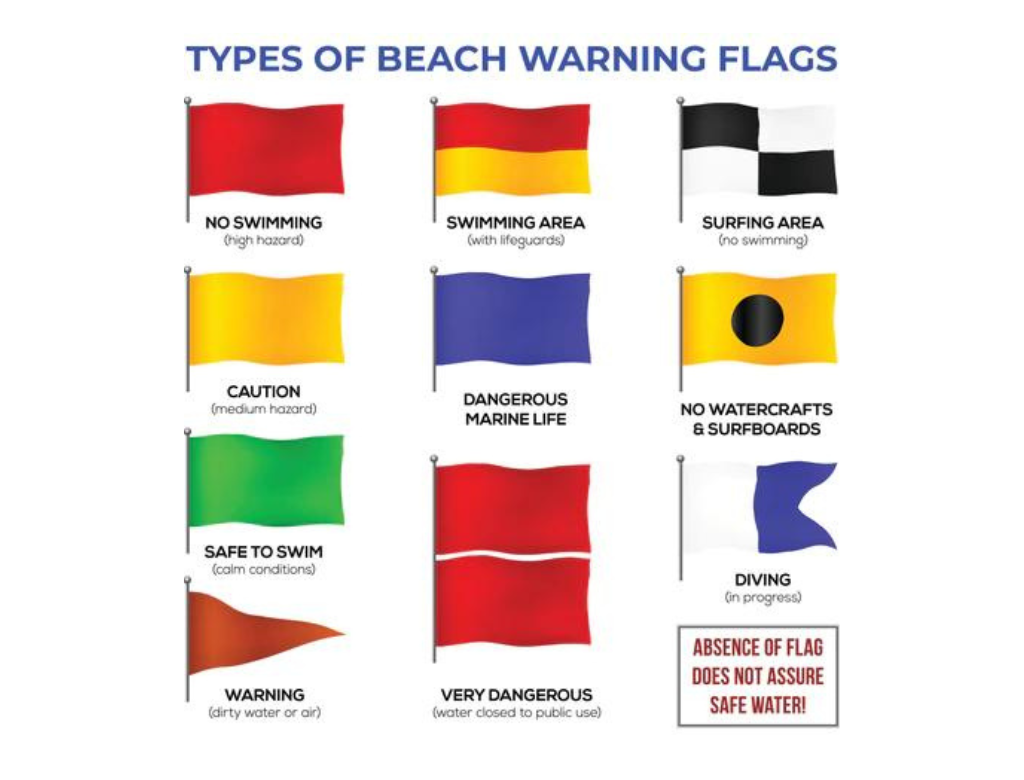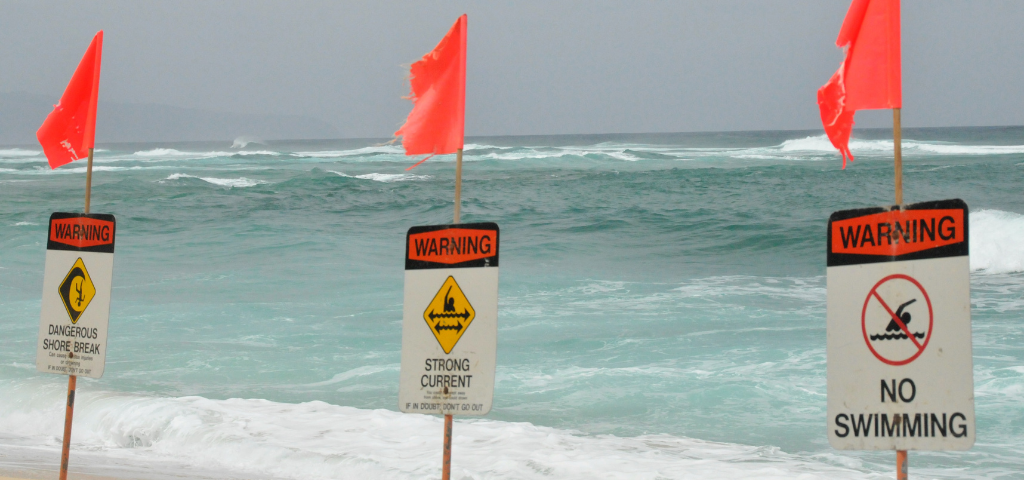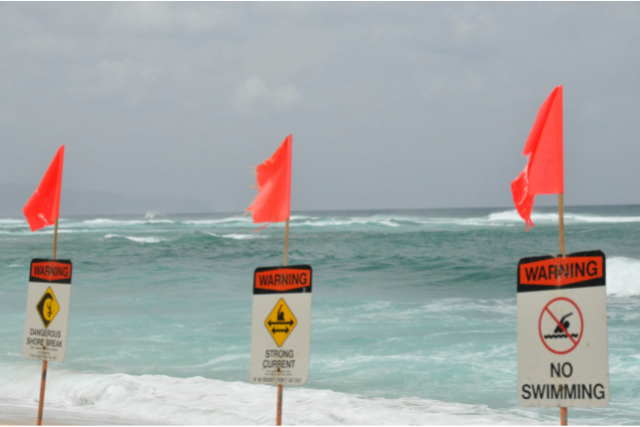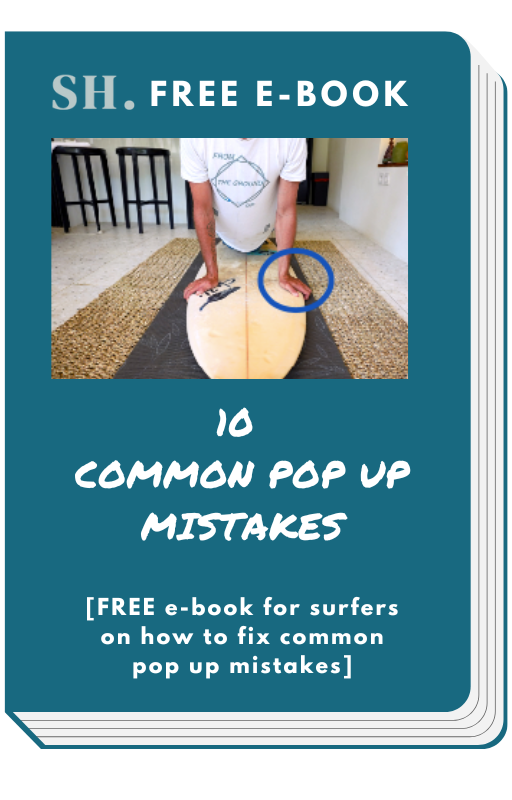Beach Safety 101
The United States Lifesaving Association (USLA) has compiled a list of the most helpful safety tips for all beachgoers.
Here and the basics to which they adhere:
- Learn to swim
- Swim with a friend
- When available, check with the lifeguards
- Always obey signs and flags
- Keep the beach and water clean
- Learn about rip currents and the safety around them
- Always enter the water feet first
- When available, swim near a lifeguard
- Stay hydrated, use sunscreen
- When necessary, wear a life jacket
Beach Flags you should know as a surfer
There are so many different beach flags and colours, but they are essential for a surfer to know about and to be aware of.
- Green Flag – The most common and widely known beach flag indicates calm conditions – safe & good for swimming. Mostly that also means no waves for surfing.
- Red flag – this indicates a high hazard. Again, the best route would be to check in with a lifeguard before entering the water.
- Yellow flag – this means a medium hazard has been observed.
- Red over red flag – when you have a red flag double-up, the beach has been closed.
- Purple Flag – There is marine life in the area, which will most likely be dangerous. Maybe a shark, perhaps some box jellyfish in the hood. Best to stay well away.
- Red over Yellow flag – The beach is lifeguard controlled, so all good.
- Quartered Flag Area -this sign simply means a demarcated area for watercraft.
- Black Ball Flag – No surfing or watercraft allowed.
- Orange Windsock Flag – powerful offshore winds, so no inflatables allowed.
- The black and white checkered flag – is well-known among surfers, as it marks an official surf zone where swimmers are not allowed.
- The red pennant flag – indicates dirty water- and/or air. You will typically see this flag at surf spots near big cities.

Shark Flags
- Red flag – dangerous surf conditions, but no sharks.
- Green flag – good visibility and no sharks
- Black flag – poor visibility, but no sharks
- White flag with shark diagram – a shark has been spotted near the beach, and surfers must get out of the water. This is often accompanied by a siren to warn everyone.
Beach signs you should know as a surfer
- Dangerous Shore break – This beach sign indicates a powerful and shallow shore break. In surfing terms, these are often called a wedge and can cause serious injuries.
- High Surf – As a beginner or intermediate uncertain about your abilities, you should look out for this sign, as it indicates big wave surfing conditions.
- Strong Currents – Some currents – like Rip currents, can actually be beneficial for surfers, but you should still familiarize yourself with the beach sign and learn to read to the ocean before paddling out.
- Slippery Rocks – At a surf spot like Punta Roca in El Salvador, where you cross a rocky shore, this sign will warn you about the slippery rocks. A slip can damage your surfboard or worse; cause an injury!
- Sharp Coral Reef – As surfers, we love coral reefs as they help form perfect and consistent waves. But some reefs are sharper than others, so you should defiantly be aware of this sign and study the ocean and tides before surfing in a new spot.
- Jellyfish & Man-O-War – Be aware of this beach sign, as these ocean creatures can be extremely annoying for surfers. However, their presence depends on the season, so the beach sign will be a friendly reminder.
- Shark Sighted – This is a warning sign! A shark has been spotted near the beach, so you should not paddle out!


Most important Beach Flags & beach signs for surfers
The most essential beach flag to look for as a surfer would be the purple flag, which indicates dangerous marine life, and the Black Ball flag, which means that you’re not allowed to surf.
Soft tops became so popular due to the Black Flag, as a soft top is not classified as a surfboard. So you can still get barrelled on your Catch Surf or your Mick Fanning Softboard during the Black Ball period.
6 Surfing Safety Tips For Beginners
A few essential tips for surfing beginners at the beach
- If present, ask lifeguards for beach advice.
- If present (and friendly), ask locals for surf advice.
- Watch locals when they paddle out.
- Look for channels as routes to paddle out.
- Look for jump spots, and don’t jump off rocks without watching someone or asking someone first.
- Play it reasonably safe in beachbreak surf until you’re confident.


